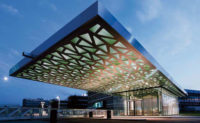Hanoi / Ho Chi Minh City
It is about 450 miles from Quang Binh province in the middle of Vietnam to Ho Chi Minh City (HCMC), the noisy, frenetic commercial capital in the south. But Vo Trong Nghia's journey from one place to the other has less to do with mileage than it does with the radical change in life experiences that came with the move. Born in rural Quang Binh in a house without electricity, Vo helped care for his family's cows as a boy. Today he and his two partners'Takashi Niwa and Masaaki Iwamoto'run a thriving practice with about 15 people in their HCMC office and 10 in Hanoi. The firm has worked on projects in various parts of Vietnam, designed the country's pavilion at the 2010 Shanghai World Expo, and is even involved in a few projects in Mexico. It's a long way from Quang Binh.
Or not. Vo says that his architecture is rooted in the lessons he learned in his childhood. When you live in a hot, humid place without air-conditioning, you understand the need for shade, water, and natural ventilation. You grasp in a very direct and meaningful way the connection between buildings and their environments. You know the versatility of local materials such as bamboo and how to use them. All of this informs Vo's architecture, whether he is designing a small caf' surrounded by a cooling ring of water, a modern townhouse with stacks of lush planters on the front and back, or a school for 800 students that blurs the boundaries between indoors and out.
On his way from the farm to the city, Vo made a rewarding detour to Japan, where he studied architecture, landscape design, and civil engineering at the University of Tokyo and the Nagoya Institute of Technology on a Japanese-government scholarship. He says he learned about the Japanese 'way of thinking toward climate and natural features' and discovered similarities with that of Vietnam. While in Japan, he met Niwa and then Iwamoto, who became his architectural partners and have moved to Vietnam. Together they are developing a body of work that integrates inexpensive, local materials and traditional skills with contemporary aesthetics and modern methodologies. So they often use bamboo, because it's a fast-growing, sustainable material familiar to local workers, but they usually assemble it off-site as prefabricated units to ensure better quality and accuracy in construction. And Vo looks at landscape in a broad way, examining how even a small project fits into the ecology of the city, as well as its immediate surroundings.
With Vietnam changing rapidly in recent years, Vo has seen the country lose much of its connection to its environment while generating a great deal of pollution. But he thinks architecture and architects can help turn things around and find better ways of building. He always looks for low-cost solutions that rely on working with natural forces rather than overcoming them. The most difficult challenge is changing the way people think, he says. In comparison, technical and money problems are easy.
Right now the firm is working on a kindergarten in Dong Nai province that will allow the students and their teachers to grow food on a long, spiraling green roof; a house in HCMC's Tan Binh district, divided into five parts with small gardens in between; and a restaurant made of bamboo that is located in a botanical garden near Cuernavaca, Mexico. No matter where the project is or how big or small it may be, Vo and his partners apply a design approach shaped by their knowledge of farm sheds in paddy fields, the metabolism of Japanese urbanism, and the need to connect modern life with the environment that will sustain it.
Vo Trong Nghia Architects
FOUNDED: 2006
DESIGN STAFF: 25
PRINCIPAL: Vo Trong Nghia, Takashi Niwa, Masaaki Iwamoto
EDUCATION: Vo: U. of Tokyo, M. Civil Engineering, Landscape, and Civil Design, 2004; Nagoya Institute of Technology, B.A., 2002. Niwa: Tokyo Metropolitan University, M. Engineering, Architecture, 2003; B.A., 2001. Iwamoto: U. of Tokyo, M. Engineering, Architecture, 2008; B.A., 2005.
WORK HISTORY: Vo: Vo Trong Nghia Architects, 2006'present. Niwa: Noriaki Okabe, 2005'10. Iwamoto: Kazuhiko Namba + Kai Workshop, 2008'11.
KEY COMPLETED PROJECTS: Binh Duong School, Binh Duong, Vietnam, 2011; Stacking Green, HCMC, 2011; Vietnam Pavilion, Shanghai, 2010; Bamboo Wing, Vinh Phuc province, 2009; wNw Cafe, Binh Duong province, 2006
KEY CURRENT PROJECTS: Farming Kindergarten, Dong Nai province, 2013; Hill restaurant, Mexico, 2013
WEB SITE: www.votrongnghia

















Post a comment to this article
Report Abusive Comment